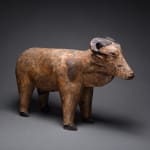Baule Wooden Ram, 20 th Century AD
Wood
40.6 x 74.9 cm
16 x 29 1/2 in
16 x 29 1/2 in
PH.0251
The Baule judged their art by strict criteria including a smooth finish, the clarity of line, and a slight inherent asymmetry; clearly this ram would have been heralded as a...
The Baule judged their art by strict criteria including a smooth finish, the clarity of line, and a slight inherent asymmetry; clearly this ram would have been heralded as a masterpiece by the Baule themselves. The ram, and in specific the ram’s horns, have been a potent symbol in world mythology throughout the ages. Ancient Egyptians worshipped multiple gods with ram’s heads including Khnum and the composite deity Amen- Ra. The Ancient Phoenician deity Ba’al, who was adopted by the Greeks as Zeus, was often depicted crowned with the horns of the ram. Throughout time, spanning across divergent cultures and civilizations, the ram has been a traditional symbol of male fertility and the hearth. The power and majesty of this beast has been long revered by mankind, and this was especially true of the Baule tribe who identified the ram and their tribal symbol.



